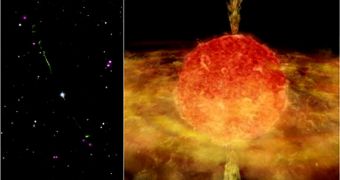Several years ago, when astronomers first pointed their telescopes towards BP Piscium (BP Psc), all they saw was a aging red giant star, that exhibited some peculiarities of its own. Now, following new studies conducted with a variety of observatories, it was revealed that the object was a cannibal.
It would now appear that the red giant is a good indicator of how our own Sun will look like a few billion years from now, as it finishes burning up its hydrogen reserves during nuclear fusion.
This reaction is what powers stars, and several scenarios are possible for when it ends. In one of them, a star inflates from its regular size into a red giant, expanding its diameter considerably in the process.
After the inflation is complete, the star sheds the outer layers of its massive atmosphere, and becomes a white dwarf, a small, helium-burning star that continues to exist for billions of years afterwards.
BP Psc is in the middle of this evolution process, in the red giant phase. But what puzzled experts when they first looked at it was that its system apparently produced radiation jets, that came out of both poles and headed into opposite directions.
Each of these jets was several light-years in length, and astrophysicists said that this was a clear indicator the system was actually made up of a young star. The object was also surrounded by a disk made entirely out of gas and dust, that looked similar to a protoplanetary disk.
But the latest observations of the star, conducted with the Chandra X-ray Observatory, reveal the gruesome truth about this star system. The disk is in fact made up of the remnants of a companion star or exoplanet, that BP Psc destroyed as it inflated into a red giant.
This most likely happened several million years ago, experts say. “It appears that BP Psc represents a star-eat-star Universe, or maybe a star-eat-planet one,” explains scientist Joel Kastner.
“Either way, it just shows it's not always friendly out there,” adds the scientist, who is based at the Rochester Institute of Technology (RIT). He was also the leader of the new Chandra research.
Scientists say that the reason the star produces its emission jets is because its internal, dynamo-like process was energized by its rapid rotation. While normally it wouldn't be able to spin this fast, it would appear that the process of consuming its companion made it increase its speed.
“It seems that BP Psc has been energized by its meal,” explains RIT expert Rodolfo Montez Jr., quoted by Daily Galaxy. He was a coauthor of the research.
“BP Psc shows us that stars like our Sun may live quietly for billions of years, but when they go, they just might take a star or planet or two with them,” adds University of California in Los Angeles expert David Rodriguez. He is also a coauthor of the study.

 14 DAY TRIAL //
14 DAY TRIAL //